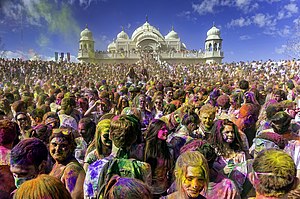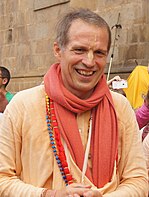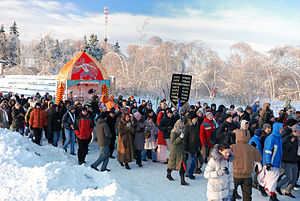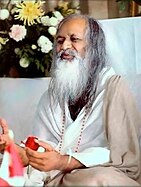Hinduism in the West
 | |
|
(Anticlockwise from top) Holi Festival in March 2013 at the Sri Sri Radha Krishna Temple in Utah County, Utah; image of Sacinandana Swami; | |
| Total population | |
|---|---|
| c. 6.8 million (0.49% of the population)[1][2] | |
| Regions with significant populations | |
| 3,369,976 | |
| 1,032,775 | |
| 828,195 | |
| 684,002 | |
| 180,000 | |
| 180,000 | |
| 150,000 | |
| 130,000 | |
| 123,534 | |
| 75,000 | |
| 50,000 | |
| 40,000 | |
| 33,043 | |
| 19,471 | |
| 12,601 | |
| 10,000 | |
| Religions | |
| Hinduism Notable Individuals Followed mostly by converted and immigrant Hindus identified as American Hindus, European Hindus, Australian Hindus, British Hindus etc. | |
| Scriptures | |
| Bhagavad Gita and Vedas | |
| Languages | |
| |
The reception of
History
Colonial period
During the British colonial period the British substantially influenced Indian society, but India also influenced the western world. An early champion of Indian-inspired thought in the West was Arthur Schopenhauer who in the 1850s advocated ethics based on an "Aryan-Vedic theme of spiritual self-conquest", as opposed to the ignorant drive toward earthly utopianism of the superficially this-worldly "Jewish" spirit.[6]
In the early 20th century, Western occultists influenced by Hinduism include
Neo-Hindu movements 1950s–1980s
During the 1960s to 1970s counter-culture,
Hindu migration to Western countries
Substantial emigration from the (predominantly Hindu)
Sadhguru's appeal to the South Asian diaspora
Jaggi Vasudev, otherwise known as Sadhguru has been influential in the revival of New Age Hinduism in the West.[citation needed] By diverging from traditional ways of teaching Hinduism, Sadhguru offers a New Age Hinduism which resonates with second-generation South-Asian Americans who are navigating the intersection of their Indian roots and Western identity.[12]
Hinduism-derived elements in popular culture
Growing out of the enthusiasm for Hinduism in 1960s
Author Kathleen Hefferon comments that "In the West, a more modernized "New Age" version of Ayurveda has recently gained popularity as a unique form of complementary and alternative medicine".[16]
"Vegetarianism, nonviolent ethics, yoga, and meditation—all have enjoyed spates of Occidental popularity in the last 40 years, often influenced by ISKCON directly, if not indirectly."[17]
See also
- Hindu reform movements
- Sanskrit in the West
- Esotericism in Germany and Austria
- Ramakrishna's impact
- Neo-Advaita
- Californian Hindu textbook controversy
- Category:Converts to Hinduism
- Hindu denominations
- Hindu Temple Society of North America, Flushing
- Hinduism in Australia
- Hinduism in Canada
- Hinduism in Europe
- Hinduism in New Zealand
- Hinduism in the United Kingdom
- Hinduism in the United States
- Indians in the New York City metropolitan area
- Invading the Sacred
- List of Hindu temples in the United States
- Organizations
References
- ^ "Hindu by country". globalreligiousfuture.org.
- ^ "ISCKON followers in the western world". krishna.org.
- ^ Johnson, Todd M.; Grim, Brian J. (2013). The World's Religions in Figures: An Introduction to International Religious Demography (PDF). Hoboken, NJ: Wiley-Blackwell. p. 10. Archived from the original (PDF) on 20 October 2013. Retrieved 24 November 2015.
- ^ "International Yoga Day: How Swami Vivekananda helped popularise the ancient Indian regimen in the West". 12 January 2022.
- ^ Feuerstein, Georg (2002). The Yoga Tradition. Delhi: Motilal Banarsidass. p. 600.
- ^ "Fragments for the history of philosophy", Parerga and Paralipomena, Volume I (1851).
- ISBN 978-1598842043.
- ^ Hevesi, Dennis (3 December 2010). "Sri Daya Mata, Guiding Light for U.S. Hindus, Dies at 96". The New York Times. New York.
- ISBN 0-691-08952-3, translated from German "Der Hinduismus" (1998) page 22
- .
- Indian American#Timeline
- JSTOR 1465852. Retrieved 12 May 2023.
- ^ Douglas A. Wengell. Educational Opportunities in Integrative Medicine: The A to Z Healing Arts Guide and Professional Resource Directory. p. 250
- ^ "Yoga Therapy in Australia" by Leigh Blashki, M.H.Sc. Archived 16 October 2013 at the Wayback Machine
- ^ "The Growing Global Interest In Yoga" Archived 7 February 2013 at the Wayback Machine Monday 16 April 2012
- ISBN 978-0199873975.
- ISBN 978-0742562370.








